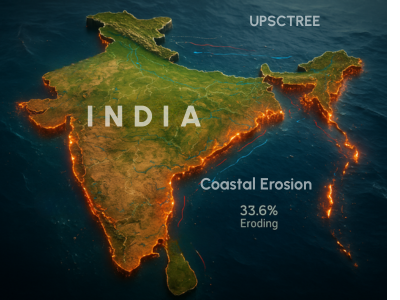India’s 7,500 km-long coastline is more than just a scenic boundary—it’s a hub of biodiversity, economy, culture, and climate resilience. But today, our coasts are under siege—from erosion, pollution, habitat destruction, and climate extremes.
🌊 India’s Coast: Beauty on the Brink

⚠️ Key Challenges Facing India’s Coasts
-
Coastal Erosion: About one-third of India’s coastline is eroding, with states like Tamil Nadu, Kerala, Karnataka, and West Bengal being most affected. Erosion is driven by natural processes (like cyclones and sea-level rise) and human activities such as urbanization, sand mining, and construction of coastal infrastructure. States like Karnataka (notably Dakshina Kannada district) have seen nearly half their coastline eroded in the last three decades, while Kerala’s Ernakulam coast battles relentless wave attacks and erosion worsened by port developments and sand dredging. This erosion leads to loss of land, displacement of communities, and damage to infrastructure.
-
Pollution: India’s coastal waters are heavily polluted by industrial effluents (accounting for nearly 40% of coastal water pollution), untreated sewage, plastic waste, and agricultural runoff. This pollution devastates marine biodiversity, threatens fisheries that millions depend on, and poses health risks to coastal populations. Despite existing laws like the Coastal Regulation Zone (CRZ) Notification and Plastic Waste Management Rules, enforcement remains weak, calling for stronger governance and community engagement.
-
Habitat Destruction: Critical coastal ecosystems such as mangroves, coral reefs, and wetlands, which act as natural buffers against storms and erosion, are being degraded by urbanization, port construction, and tourism. For example, the Sundarbans mangroves are vital for cyclone protection but are under threat from rising seas and human encroachment. Loss of these habitats reduces the coast’s resilience to climate shocks and biodiversity loss
-
Overexploitation of Resources: Unsustainable fishing practices, including illegal light fishing, have depleted marine life and undermined the livelihoods of traditional fishing communities.
-
Climate Change: Sea levels along India’s coast have risen by approximately 8.5 cm over the past 50 years, with projections warning of up to 1.2 meters rise by 2100 if greenhouse gas emissions continue unabated. This rise exacerbates flooding, saltwater intrusion, and habitat loss. Coastal megacities like Mumbai, Chennai, and Kolkata face severe risks of inundation, while rural communities, such as those in Odisha’s Satabhaya village, are already experiencing forced relocations due to repeated flooding and erosion.
-
Governance and Regulation: While India has a framework of laws and policies to protect its coasts, including CRZ notifications and environmental acts, enforcement gaps and outdated coastal maps hamper effective management. Coastal protective structures like seawalls and groynes are widely used but often insufficient or damaged, as seen in Kerala’s Ernakulam coasts. Innovative solutions such as geotubes have been introduced but require further evaluation.
Implementation of coastal regulations (like the Coastal Regulation Zone notifications) faces challenges due to weak enforcement, lack of coordination among agencies, and outdated mapping. The recent revision of India’s coastline length (now over 11,000 km) adds complexity to regulation and planning.
-
Socio-Economic Pressures: The erosion and climate impacts have led to the emergence of “ghost villages” along the east coast, where entire communities have abandoned homes due to environmental degradation. Villages like Uppada in Andhra Pradesh have lost hundreds of houses, markets, and schools to the sea, forcing large-scale migration. Livelihoods dependent on fishing and agriculture are severely disrupted by habitat destruction, salinization of soil, and declining fish stocks, threatening food security and economic stability
🔬 What Can Be Done?
1. Integrated Monitoring
- Use a real-time web of satellite, aerial, and ground data to understand the shifting coastline.
2. Eco-Restoration & Soft Engineering
- Replace concrete with nature: rebuild mangroves, coral reefs, dunes, and wetlands to protect coasts.
3. Smart Policy Backed by Science
- Move beyond ad-hoc solutions. Build science-informed policies using long-term coastal vulnerability models.
🧭 Final Thought:
“The coasts are not merely land meeting sea—they are living, breathing ecosystems on which millions depend.”
India’s coastal future demands more than short-term fixes. It needs an interdisciplinary, collaborative strategy—where technology meets tradition, and ecology shapes economy.


